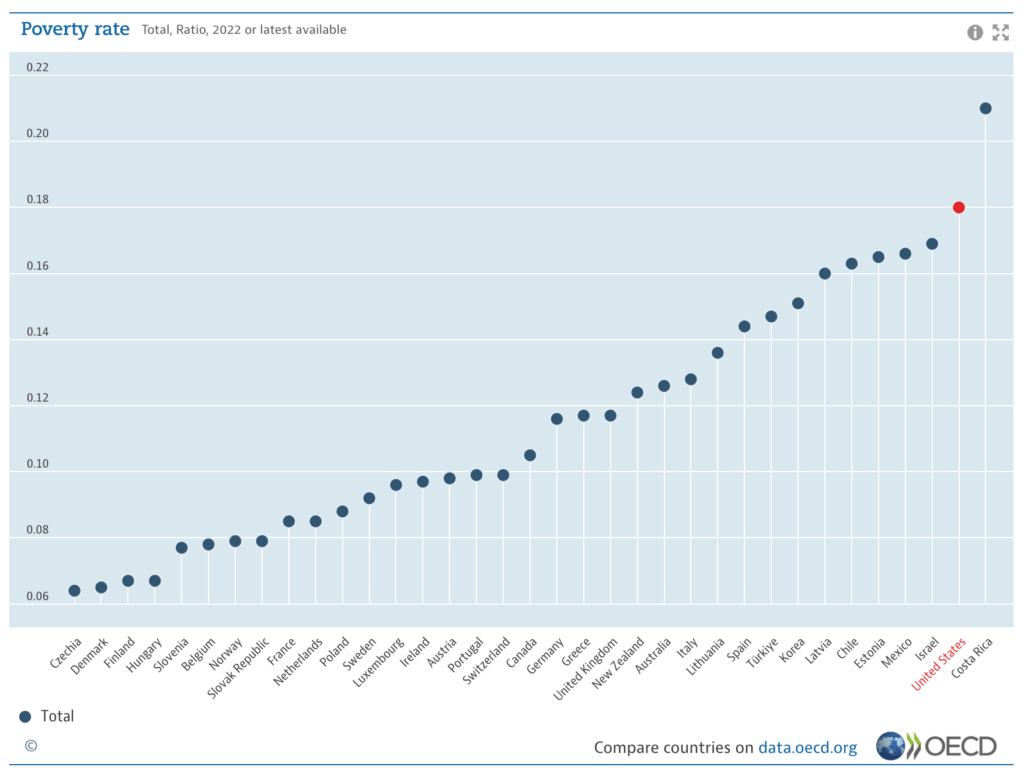GiveDirectly began delivering cash donations in Kenya, but we’ve run programs in the United States for the past five years: first responding in 2017 to Hurricane Harvey in Texas and Hurricane Maria in Puerto Rico. When COVID-19 hit, we launched Project100, the largest donor-funded cash aid program in U.S. history. Beyond emergency response, we have launched three of America’s largest guaranteed income programs – together, they’ll deliver $82M to 8,910 households over the next two years.
We believe working in the U.S. gives us an opportunity to create meaningful change in the lives of low-income Americans and the policies that impact them. It also drives innovation and grows donor-support for our international work.
Many Americans experience unaddressed material hardship, which we can help change
The U.S. spends about what most wealthy countries spend on social protection, but much of that spending goes to poorly designed social programs that carry excessive bureaucratic burden, meaning qualified families do not enroll – over a quarter of Americans living in deep poverty (less than half of the federal poverty line) are not enrolled in any federal safety net program. Furthermore, many of these programs are not unconditional cash aid, and instead take the form of less effective and paternalistic in-kind or conditional support (e.g. CA’s WIC requirements). Furthermore, they definitionally exclude millions of undocumented households. These failures are why, despite significant spending, the U.S. still has the second highest poverty rate relative to national income of any wealthy country in the world:

GiveDirectly will improve the lives of low-income Americans by contributing to government program design and the U.S. cash research base. Our programs with the City of Chicago and Cook County, IL, have allowed us to implement large government aid programs that are more equitable and accessible than traditional ones. All three of our guaranteed income programs include complementary research components, which will add to the relatively small pool of evidence on cash aid in high income countries. In total, these efforts will help optimize existing and future social safety net spending.
We’ve improved emergency relief, which is often too slow or poorly targeted to truly help low-income Americans
In the U.S., large-scale emergencies like hurricanes are met by a combination of government and nonprofit responses. Government response is often poorly targeted, benefiting wealthy Americans. There’s also always a large but dispersed effort of community groups and private companies sending in goods. These donations are well-meaning but often unhelpful, sending truckloads of stuff like clothing, lotion, or fridges that end up plopped in a parking lot with no plan for distribution.
In these situations, the most vulnerable people are often the poorest, those without savings to afford evacuation, essentials, and rebuilding. What they need is money. Many donors realize this and will give generously to un-vetted GoFundMe’s or find DIY means of sending direct cash transfers through Airbnb or Etsy. GiveDirectly and our partners have provided donors a more reliable, fast, and well-targeted system to deliver funds directly to low-income Americans:
- For hurricanes, we developed first-in-class targeting tools that combine storm damage and poverty data to find those most in need.
- Our pandemic response was launched nearly a month faster than the federal response, reaching low-income Americans through a digital app.
These innovations ensure donor dollars are spent where needed most – not on those with the most compelling story.
U.S. and international funding comes from separate, quite large pies
We’re sometimes asked, “Won’t money do more good in Africa than the U.S.?” Assumed in this question is the idea that all funding comes from the same pie. However, a dollar directed to low-income Americans is not a dollar taken from our international programs. Our U.S. emergency programs are funded by donors and foundations uniquely interested in giving to Americans. Currently, over 80% of our guaranteed income funding comes from governments – a county or municipality has a budget they want to direct to their poorest citizens and we design and implement the program.
The ‘funding pies’ for U.S. and international poverty work are both quite large: annually over $160B is spent on international development, the U.S government spends over $750B on social protection, and billions more are given by donors and foundations to both. We’re only yet scratching the surface of either.
Running U.S. programs does not come at a cost to our international work. In fact, they work in complement:
- We’ve driven over $70M to international programs from donors who initially gave to U.S. projects.
- Our U.S. work has been featured in dozens of major domestic press outlets, drawing attention to our overall work as an organization that we wouldn’t have received otherwise.
Early innovations in our U.S. work (satellite mapping for disaster damage & end-to-end digital payments) were then adapted for our international programs.
Working in the U.S. and internationally results in more total good
As an organization, we deliver donations directly to people in poverty. Donations delivered in Africa reach objectively poorer people and those people have access to cheaper goods and services, so that money goes “further.” Yet millions of people in the U.S. truly need help, and many of their fellow Americans want to support them. By connecting these two groups with an efficient, targeted way to send unconditional support, we’re able to do more total good in the world.
Our donation page lets you direct to international or U.S. – the choice is ultimately up to you.